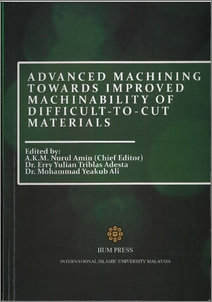Amin, A. K. M. Nurul and Alam, S. and -, Syedatul Akma
(2011)
Optimization of surface roughness in high speed end milling of Titanium alloy Ti-6Al-4V under dry conditions.
In:
Advanced Machining Towards Improved Machinability of Difficult-to-Cut Materials.
IIUM Press, International Islamic University Malaysia, Kuala Lumpur, Malaysia, pp. 181-187.
ISBN 9789674181758
![[img]](http://irep.iium.edu.my/style/images/fileicons/application_pdf.png)  Preview |
|
PDF (Optimization of surface roughness in high speed end milling of Titanium alloy Ti-6Al-4V under dry conditions )
- Published Version
Download (554kB)
| Preview
|
Abstract
The techniques of High Speed Machining (HSM), while still in an initial stage of wide
acceptance, have already been proven in leading aircraft manufacturing plants [1]. HSM has
been applied successfully to materials like magnesium and aluminum. Among the titanium
alloys, Ti-6Al-4V being the most commonly used and it is the workhorse alloy of the titanium
industry, accounting for over 45% of the total titanium production [2]. Therefore, the efficiency
of titanium machining is one of the major challenges in production engineering. Various studies
have been conducted on the surface roughness in end milling of various materials using deferent
cutting tools, experimental and optimization techniques. Baek et al [3] selected the optimal
187ederate using a bisection method. Peigne et al [4] studied effects of the cutting vibratory
phenomena and their impacts on machined surface roughness. Franco et al [5] developed a
numerical model for predicting the surface profile and surface roughness in face milling with
round inserts. Alauddin et al [6] used RSM and ANOVA to optimize the surface finish in endmilling
of Inconel 718. Only two cutting parameters (i.e., cutting speed and feed rate) were
considered, and 13 experiments were conducted. An important parameter (depth of cut) was not
considered. Choudhury et al [7] noticed that the surface finish improves with increase of the
cutting speed at constant feed rate and constant depth of cut in machinability assessment of
Inconel 718. Kuang-Hua Fuh and Chih-Fu Wu [8] used RSM for surface quality prediction in
end milling of Al-alloy. Beside the usual cutting variables, they considered nose radius and flank
width as parameters to be optimized.
In this study, 3-level full factorial experimental designs of RSM were used for high speed end
milling of Ti-6Al-4V. The 3-level factorial method was used to study qualitatively the 3D (three
dimensional) surface morphologies/topographies for the machined surfaces of Ti-6Al-4V to
determine the machining conditions that could give the best possible surface finish. Desirability
function of RSM was applied to optimize the cutting parameters.
Actions (login required)
 |
View Item |


 Download Statistics
Download Statistics Download Statistics
Download Statistics